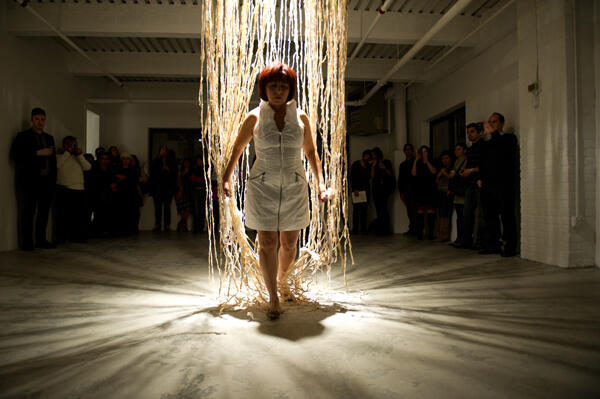María Evelia Marmolejo
Mandragoras Art Space, Long Island City, New York
An acrid smell hangs thickly in the air of the Mandragoras Art Space where the crowd sips on red wine in anticipation of legendary Colombian performance artist María Evelia Marmolejo.

Revered for defying the conventions of 1980’s artistic practices by determinedly implicating her physicality, Marmolejo’s provocations have come to be characterized as political, radical and feminist.
“May 1st 1981- February 1st, 2013” is all three of these but is delivered with a subtle sophistication of a seasoned artist. In the center of the first room a square of salted cow intestines hang from the ceiling. Marmolejo enters in a modest white dress and approaches a bandage lying on the floor next to a curled dried intestine. Standing in front of a large rectangular mirror she places the ends of the bandage and the intestine in her mouth and begins to twist them to make a rope, appearing as a nurse binding the wounds of past carnage. She enters the second room, where the reek of fresh hanging cow intestines is grossly unsettling. This is unarguably the present. She inspects, circles and pokes her toe at edges of the gooey guts as if searching for life, and runs her hand down the long shimmering cords of innards that irreparably stain her dress.
Repeating the action, she twists the bandage and fresh intestine into a skipping rope and begins to skip. The action recalls childhood, but as the innards “thwack” the cement floor it serves as a reminder of enduring hardship. The war persists today.
She returns to the first room—the past—where she removes her dress to stand naked amongst the dried intestines, recalling the memories of lives, opportunities and struggles lost. She dresses and makes one last call to the present where she angrily grabs at the fresh flesh.
Then, as if to fulfill the cycle of life, she picks up both ends of the twisted bandaged intestines and after circling the room one last time, hands them off to unsuspecting onlookers. She has passed on the burden of responsibility by making others accountable. Her role, as a women tending the wounds of the past and dealing with conflicts of the present, comes to an end. Marmolejo’s message is clear, poetic without being overly symbolic, and manages to captivate over thirty years later when the idea for the project first began.
-
 "May 1st, 1981 - February 1st, 2013"
"May 1st, 1981 - February 1st, 2013"
performed at MAAS.
Photo by Agata Domanska @ MAAS.






